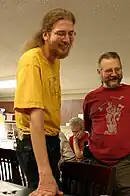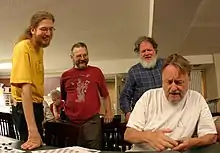Erik Demaine
Erik D. Demaine (born February 28, 1981) is a Canadian-American professor of computer science at the Massachusetts Institute of Technology and a former child prodigy.
Erik D. Demaine | |
|---|---|
 | |
| Born | February 28, 1981 Halifax, Nova Scotia, Canada |
| Nationality | Canadian and American |
| Alma mater | Dalhousie University University of Waterloo |
| Awards | MacArthur Fellow (2003) Nerode Prize (2015) ACM Fellow (2016) |
| Scientific career | |
| Institutions | Massachusetts Institute of Technology |
| Thesis | Folding and Unfolding (2001) |
| Doctoral advisor | |
| Doctoral students | |
Early life and education
Demaine was born in Halifax, Nova Scotia, to mathematician and sculptor Martin L. Demaine and Judy Anderson. From the age of 7, he was identified as a child prodigy and spent time traveling across North America with his father.[1] He was home-schooled during that time span until entering university at the age of 12.[2][3]
Demaine completed his bachelor's degree at 14 years of age at Dalhousie University in Canada, and completed his PhD at the University of Waterloo by the time he was 20 years old.[4][5] Demaine's PhD dissertation, a work in the field of computational origami, was completed at the University of Waterloo under the supervision of Anna Lubiw and Ian Munro.[6][7] This work was awarded the Canadian Governor General's Gold Medal from the University of Waterloo and the NSERC Doctoral Prize (2003) for the best PhD thesis and research in Canada. Some of the work from this thesis was later incorporated into his book Geometric Folding Algorithms on the mathematics of paper folding published with Joseph O'Rourke in 2007.[8]
Professional accomplishments

Demaine joined the faculty of the Massachusetts Institute of Technology (MIT) in 2001 at age 20, reportedly the youngest professor in the history of MIT,[4][9] and was promoted to full professorship in 2011. Demaine is a member of the Theory of Computation group at MIT Computer Science and Artificial Intelligence Laboratory.
Mathematical origami artwork by Erik and Martin Demaine was part of the Design and the Elastic Mind exhibit at the Museum of Modern Art in 2008, and has been included in the MoMA permanent collection.[10] That same year, he was one of the featured artists in Between the Folds, an international documentary film about origami practitioners which was later broadcast on PBS television. In connection with a 2012 exhibit, three of his curved origami artworks with Martin Demaine are in the permanent collection of the Renwick Gallery of the Smithsonian Museum.[11]
Demaine was a fan of Martin Gardner and in 2001 he teamed up with his father Martin Demaine and Gathering 4 Gardner founder Tom M. Rodgers to edit a tribute book for Gardner on his 90th birthday.[12] From 2016 to 2020 he was president of the board of directors of Gathering 4 Gardner.[13]
Honours and awards
In 2003, Demaine was awarded the MacArthur Fellowship, the so-called "genius grant".[14]
In 2013, Demaine received the EATCS Presburger Award for young scientists. The award citation listed accomplishments including his work on the carpenter's rule problem, hinged dissection, prefix sum data structures, competitive analysis of binary search trees, graph minors, and computational origami.[15] That same year, he was awarded a fellowship by the John Simon Guggenheim Memorial Foundation.[16]
For his work on bidimensionality, he was the winner of the Nerode Prize in 2015 along with his co-authors Fedor Fomin, Mohammad T. Hajiaghayi, and Dimitrios Thilikos. The work was the study of a general technique for developing both fixed-parameter tractable exact algorithms and approximation algorithms for a class of algorithmic problems on graphs.[17]
In 2016, he became a fellow at the Association for Computing Machinery.[18] He was given an honorary doctorate by Bard College in 2017.[19]
References
- Kher, Unmesh (September 4, 2005). "Calculating Change: Why Origami Is Critical to New Drugs: The Folded Universe". Time. Archived from the original on September 8, 2005. Retrieved February 28, 2011.
- Barry, Ellen (February 17, 2002). "Road Scholar Finds Home at MIT". The Boston Globe. Retrieved April 15, 2008.
- Nadis, Steve (January 18, 2003). "Prodigy prof skipped school until he started college at 12". New Scientist. Retrieved November 10, 2013.
- Wertheim, Margaret (February 15, 2005). "Origami as the Shape of Things to Come". The New York Times. Retrieved April 15, 2008.
- O'Brien, Danny (August 19, 2005). "Commercial origami starts to take shape". The Irish Times. Retrieved April 15, 2008.
- Erik Demaine at the Mathematics Genealogy Project
- "National honour for Demaine". University of Waterloo. March 31, 2003. Retrieved April 15, 2008.
- Demaine, Erik; O'Rourke, Joseph (July 2007). Geometric Folding Algorithms: Linkages, Origami, Polyhedra. Cambridge University Press. pp. Part II. ISBN 978-0-521-85757-4.
- Beasley, Sandra (September 22, 2006). "Knowing when to fold". American Scholar. 75 (4).
- Curved Origami Sculpture, Erik and Martin Demaine.
- "Erik Demaine". Artists. Smithsonian American Art Museum. Retrieved September 18, 2022.
- A Lifetime of Puzzles: A Collection of Puzzles in Honor of Martin Gardner's 90th Birthday (AK Peters). ISBN 9781568812458
- "About Gathering 4 Gardner Foundation". Gathering 4 Gardner. August 12, 2016.
- Neal, Rome (October 4, 2003). "Behind The 'Genius Grants'". CBS News. Retrieved August 29, 2017.
- "Presburger Award 2013". Retrieved February 15, 2013.
- "Erik Demaine at the John Simon Guggenheim Memorial Foundation". Archived from the original on April 30, 2013. Retrieved April 23, 2013.
- Hajiaghayi Wins 2015 Nerode Prize, University of Maryland Institute for Advanced Computer Studies, May 8, 2015, retrieved September 3, 2015.
- "ACM Fellows":Erik Demaine
- "Congressman John Lewis will deliver commencement address at Bard", Hudson Valley One, February 22, 2017
External links
- Erik Demaine
- Biography in MIT News
- Between the Folds Documentary film featuring Erik Demaine and 14 other international origami practitioners
- Erik Demaine publications indexed by Google Scholar
.jpg.webp)